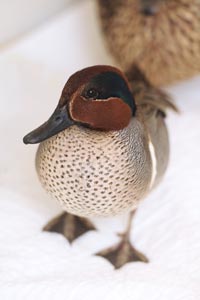Green-winged teal with injured wing

Around twilight on a March evening, a man spotted a duck running along the ground near his home in Johnson Canyon, near Kanab, Utah. There were no ponds, lakes or even streams anywhere nearby, and the duck seemed out of place and unable to fly. The man scrambled after her, and finally managed to get hold of her. He kept her overnight in his chicken coop, and in the morning brought her to Wild Friends at Best Friends.
Carmen Smith, Wild Friends manager and licensed wildlife rehabilitator, recalls that the duck, a lovely little green-winged teal, settled in quickly. The first day she was eating much of her nutritional pellet diet, along with greens. Like other ducks, she enjoyed finding her dinner floating in her water dish.
 Green-winged teal duck with wing injury
Green-winged teal duck with wing injury
X-rays at the Best Friends Animal Clinic revealed that the bird had a wing injury. By a stroke of good luck, a larger wing bone was holding a smaller broken bone in place. Veterinarians determined the wing would heal well without the need for an unwieldy splint.
Soon, the teal’s caregivers got her to eat medicated food, which meant she didn’t have to fuss about taking her medicine anymore. For now, she’s staying in a four-foot soft cage with a deep dish, which serves as a mini pond for her to splash in.
A bird with her own preferences
The teal has developed a unique relationship with her food bowls. Only white ceramic bowls, one and a half inches deep and six inches across, will do. She rejects all other bowls as not good enough.
Trying natural-looking bowls, including some that look like a hollowed-out rock, seemed like a good idea, but the teal didn’t think so, and will only accept the white ceramic bowls, so that’s what she gets.
She’s also made it clear that she only tolerates the care she’s getting as she recuperates. She’d prefer not to be handled and grunts her displeasure when a caregiver needs to pick her up for medical treatment. But it’s all in the interest of getting her back into the wild again, and she’s getting closer to that.
Making progress toward being released back to the wild
Soon, the teal will get her third set of X-rays. Her fracture needs to heal well enough for her to be able to swim in a small pool, as a first step. Then, she’ll be re-acclimated to being outside, living in an outdoor aviary, getting into shape to be released back to the wild. Having been out of commission for several weeks, she’ll need to fully regain her strength.
Finding a good release site is important too, and much care will go into finding just the right place. Often, a rehabilitated wild bird can be returned to where she was found, but not always – especially if she’s a duck found far from water. She will need to go where there are other green-winged teals, on a migration flyway, so she can fly with the others in the fall. She’ll need to keep a wary eye open for aerial predators as well.
Being a wild bird, she’ll be overjoyed to be back out in the wild in time for the beautiful days of summer. There will be no more white ceramic dinner bowls for her; she will be swimming free on the open water and flying high through the clear air.
Learn more about how Best Friends cares for wildlife at the Sanctuary.
Photos by Molly Wald